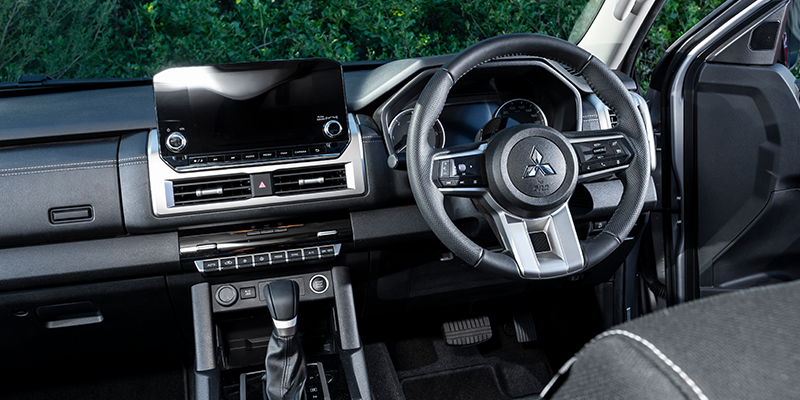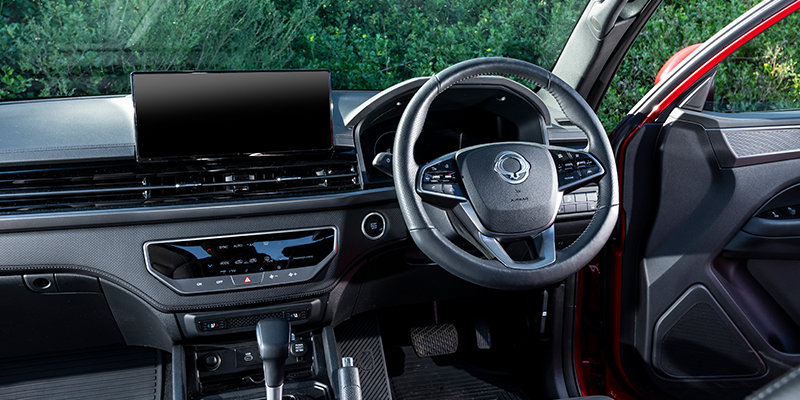4 July 2024
Words by Tim Pomroy
Photos by Anthony Warry
For the Open Road magazine
GWM Cannon XSR vs Mitsubishi Triton GLS vs SsangYong Musso comparison review


Two newcomers, the GWM Cannon SsangYong Musso, take on dual-cab ute royalty in the latest Mitsubishi Triton.
The Mitsubishi Triton forged a reputation for providing most of the gizmos and off-road capability found in the Ford Ranger and Toyota Hilux at a substantially lower price. But are the host of new budget brands entering the market, many from China, beating the Triton at its own game? We put it up against the GWM Cannon and SsangYong Musso to find out.

GWM Cannon XSR
Great Wall Motors (GWM) Group is China’s largest SUV and pickup truck manufacturer, entering our market inauspiciously in 2009. Its ute range, distributed by an independent automotive group, was one of the cheapest in the market at the time, but sales proved modest and a two-star ANCAP safety rating sealed its fate. Now under factory control, the GWM banner has a burgeoning portfolio including the Haval SUV and Ora EV range and GWM 4X4s including the Cannon ute and the Tank.
Price and warranty
The Cannon range arrived in late 2020 in dual cab configuration offering three spec levels and achieved a five-star ANCAP safety rating in 2021. Since then, the line up has grown and will include a hybrid powertrain option later this year.
Our XSR test ute is currently the hero model in the line-up, priced at $52,990 drive away ($595 extra if you choose a colour other than white). Setting it apart from the rest of the range are unique bumpers, grille, sports tray bar and air snorkel. Off-roaders will note it’s not all cosmetic, with Cooper all-terrain tyres fitted to new black-finish 18-inch alloy wheels, additional underbody protection and a new part-time AWD system with high and low selectable modes.
Sweetening the deal is GWM’s seven-year unlimited kilometre warranty, five years of roadside assistance, and five-year capped price servicing.
Specs and design
Powering the XSR is GWM’s 2.0-litre turbo diesel delivering 120kW and 400Nm mated to an eight-speed automatic. The package delivers a claimed combined fuel consumption figure of 9.4L/100km.
The XSR’s suspension design mirrors the bulk of the category – double wishbones up front and leaf springs at the rear. Adding a contemporary touch are four-wheel disc brakes and an electric handbrake. Inside, the general cabin layout is user friendly while comfortable seats with pleated leather facings have raised the bar. Same goes for the rear, where there was more foot space than in the other two and it was a toss up between the Cannon and the Musso for best overall rear comfort.
The spec list makes for juicy reading, with LED headlights and taillamps, heated leather-appointed seats with electric six-way adjustment for the driver, a sunroof, nine-inch infotainment screen, and front and rear differential locks. The XSR has a 3000kg towing rating.
The safety kit onboard is equally extensive and comprises a centre airbag, forward collision warning, lane departure warning, lane keeping assistance, lane centring, and traffic sign recognition among much else.
Driving and performance
The XSR is clearly aimed at buyers wanting to venture off-road and is the only one of the trio fitted with all-terrain tyres, 265/65X18 Coopers, compromising its ride on bitumen compared to the Triton and Musso. They are both fitted with less aggressive highway-biased tyres of similar dimensions.
Around town the XSR certainly felt taut and firm; on our highway loop the firm ride quickly became apparent and pushed along it didn’t feel as grippy though the bends. The driving dynamics weren’t helped by dull steering, and the overly intrusive lane keeping assistance constantly tugs on the steering wheel, making for a fidgety rather than relaxed drive.
While the 2.0-litre turbo diesel gives away some power and torque to the larger diesels powering the Triton and Musso, under most driving conditions the XSR cruises along smoothly and the eight-speed is quick to downshift. The package returned 9.1L/100km during our test. Accelerating up steeper sections of road exposes the lack of torque and both the Triton and Musso are more spirited performers at highway speeds.

Mitsubishi Triton GLS
The latest Triton builds on a heritage that stretches back decades. Early on, Mitsubishi recognised that by offering more ‘car-like’ levels of comfort and specification the Triton would appeal to a broader audience than just tradies. Since then it’s garnered a legion of fans from both private and commercial markets. The new range, launched earlier this year, comes hot on the heels of new models and upgrades from all the major players in a segment that features three dual cab models in the top ten vehicle sales.
Price and warranty
Tritons were always good value for money and while prices have increased significantly with the new range, there is much more kit on board and a raft of mechanical improvements. Prices start at $43,690 for the GLX and our GLS is priced at $59,090, the most expensive of our trio by a fair margin. A five-year/100,000km is offered and if owners choose to service their Triton within the Mitsubishi Network, a 10-year/200,000km warranty is provided.
Specs and design
Under the bonnet sit a new 2.4-litre Bi-turbo diesel and updated six-speed auto. Two turbos, a small one that spins up quickly on initial take-off and a larger one that comes into play as engine revs increases are designed to reduce turbo lag and produce a wide fat torque band. The result is an impressive 150kW @ 3500rpm and 470Nm between 1500 – 2750rpm and a claimed combined fuel consumption figure of 7.7L/100km.
The chunky new design is worlds apart from the previous generation yet inside the GLS feels strangely familiar. The supportive front seats provide a better driving position than previous Tritons and were judged to be the most comfortable on this comparison. Not so in the rear, where compared to the Cannon and Musso there was less foot space and the rear seats, while nicely sculpted, didn’t have the same level of support. Ergonomically, apart from the centre console lid/armrest being too short, the overall design works well.
The new Triton was awarded a Five-Star ANCAP rating and includes a driver monitor system. Using a camera mounted on top of the steering column, behind the steering wheel, it's designed to detect drowsiness alerting the driver with a message in the instrument cluster. The system has its limitations and doesn’t work if you drive with sunglasses, bringing up an alert message saying the system is unable to operate. It's irritating to say the least, and we were constantly clearing the message only for it to pop up again. Rear automatic emergency braking makes its debut as does front and rear cross traffic alerts and lane departure prevention.
Driving and performance
The new engine and revised six-speed feels more alive than the Cannon and Musso especially off the mark where maximum torque arrives at 1500rpm and the extra power and torque noticeable on winding sections of our test loop giving it an edge. It's frugal, returning 6.7L/100km. The GLS felt the most resolved over varied road surfaces, the new electric steering, springs and dampers combining to deliver a degree of sophistication not felt in the in the other combatants.
The Triton's suspension has been completely revamped and features electric power steering for the first time plus longer travel, larger diameter dampers. Front and rear springs are all-new too and the range now has a 3,500kg tow rating.

SsangYong Musso XLV ELX Luxury Ultimate
SsangYong was established in Korea in 1954 and is the oldest Korean manufacturer of 4X4’s and SUVs. The first Musso was launched here back in 1994 and the brand has been in and out of our market ever since. In 2011, Indian motoring conglomerate Mahindra bought a controlling interest and it’s been quietly building a reputation as a solid alternative to the major players in the segment.
Price and warranty
The ELX auto is the entry point into their dual cab ute 4X4 range with a recommended drive away price of $40,000.fur
Our test vehicle was the Musso Ultimate with XLV and Luxury Pack, priced at $49,500 drive away (metallic paint $595 additional.) The range includes standard and XLV long wheelbase variants, and our test vehicle was the long wheelbase version which uses conventional leaf spring rear suspension enabling a higher payload of 1025kgs compared to the 820kgs for the short wheelbase coil spring versions. Rated towing is 3,500kgs. The tray for long wheelbase models measures 1600x1570x575mm, comfortably the biggest of the trio.
Owning a Musso won’t break the bank and includes a seven-year warranty with unlimited kms, seven years roadside assist, and seven years fixed price servicing of $375.00. Nationally they have 71 dealerships.
Specs and design
Powering the Musso is their four-cylinder 2.2-litre turbo diesel developing 133kW and 420Nm developed from 1400-2800 rpm. Matched to a six-speed automatic transmission, it has a claimed fuel consumption of 8.9L/100kms.
There is a lot of kit onboard the Ultimate highlighted by the new larger 12.3-inch touchscreen sitting prominently on top of the dash. Dual zone climate control air conditioning controls feature as well, touch sensing front door locks, 360-degree camera and a heated steering wheel. The Luxury pack includes a sunroof, leather seats with electric adjustment and heated outboard rear seats.
Safety kit has improved with the addition of rear cross traffic alert, blind spot warning, lane-change collision warning, safety exit warning, complimenting autonomous emergency braking, lane departure warning, front collision warning, high beam assist, and a reverse camera with rear park sensors. Problematic for fleet and private buyers alike is the lack of an ANCAP safety rating which for many takes it off the table as a commercial fleet purchase.
XLVs with their longer tray presents somewhat of an awkward looking outline and it's less macho looking than the chunkier Triton and Cannon. The interior is much better executed and wouldn’t look out of place in a contemporary SUV, highlighted by the large digital speed readout, new infotainment screen, and the placement of the major switchgear generally well laid out. Seat comfort in all positions impressed and in the rear legroom and foot space was generous. Lack of A pillar grab handles was a minor gripe and the addition of a leather wrapped steering wheel a welcome addition over the plastic tiller in the previous Musso we reviewed.
Driving and performance
On road the Musso has always been a stellar performer in our view, that’s been enhanced by a recent upgrade that included new design body to chassis mounts and its overall refinement remains impressive. The 2.2-litre turbo diesel remains auto quick shifting when you need to accelerate and returned 8.3L/100km. It matches the Tritons confidence through corners and the steering is much better than the Cannon’s and it's nicely weighed and not too dull in feel. Without any load in the rear the Musso ride quality equals the Triton with the Cannon a distant third.
Dual cab utes can be a handful in tight spaces and a few mm in wheelbase and turning circle measurements make a difference. The Musso’s XLV’s 3,210mm wheelbase and tighter 12.2 metre turning circle versus the Triton's (3,130mm -12.7 metres) and the Cannon’s (3230mm, - 13.1 metres) provided an edge when parking.

Final thoughts
Alongside Toyota’s Hi-Lux and Nissan’s original 720 dual cabs, Triton’s have been part of the ‘holy trinity’ of utes for decades here. GWM’s Cannon and SsangYong’s Musso are the new kids on the block so to speak, and they stack up in just about every area, notably on price.
Weighing against the Cannon is its uncompromising ride and less grunty diesel and while the Musso has no ANCAP safety rating: the chocolates go to the new Triton in this contest.










